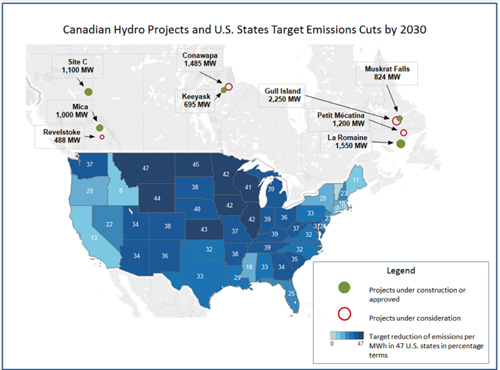Market Snapshot: Electricity from Canadian Non-Emitting Sources Qualify Under the U.S. EPA’s Final Clean Power Plan
Release date: 2015-08-20
Electricity exports from Canada are included among the greenhouse gas (GHG) reduction options available to U.S. states under the final version of the Clean Power Plan (CPP), released by the U.S. Environmental Protection Agency (EPA) on 3 August 2015. The final CPP allows states to count imports from non-emitting sources toward their targets if the sources were developed after 2012.Footnote 1 This allowance is in step with the EPA’s objective of maximizing flexibility and options for the states to achieve the reductions, and is supportive of additional electricity trade between Canadian utilities and U.S. states looking to reduce the GHG intensity of its electricity sector.Footnote 2
Proposed Canadian Hydro Projects and U.S. States Target Emissions Cuts by 2030 (in percentages)
Figure Sources and Description
Sources: EPA, provincial utility websites and plans, NEB
Description: The map shows emissions reduction goals (the relative difference between the 2030 emissions goal and the 2012 emissions) for 47 U.S. states in percentage terms and the location of nine major Canadian hydroelectric projects under construction or under consideration.
The EPA presented specific goals for 47 statesFootnote 3 in terms of total CO2 emissions to be reduced, and as a percentage of emissions to be cut by fossil fuel power plants. States can choose between the two goals. The targets for some states imply greater reductions in percentage terms relative to 2012 emission rates. Many of the states that have higher implied reduction rates are located in the Midwest and these states could be especially interested in purchasing electricity from proposed hydro projects in Manitoba or from wind and solar projects in Ontario. In fact, analysis by the North American Electric Reliability Council suggested that Canadian exports to the U.S. would see a three-fold increase as a result of the CPP’s implementation, with most of the increase sent to the Midwest states.
Some of the Midwest states are already amongst the largest purchasers of Canadian electricity: each year since 2012, over 85 per cent of Canadian electricity exports have been sold in just seven states: New York, Vermont, Michigan, California, Maine, Minnesota and North Dakota.
While almost two-thirds of Canada’s electricity supply comes from hydro-electric facilities, nearly all of the exports (about 96-98 percent) are sourced from four provinces with large hydro-electric capacities (i.e. Quebec, Ontario, Manitoba, and British Columbia).Footnote 4 Each of these provinces have proposals to build significant amounts of non-emitting generators, including hydro, wind, solar and possibly nuclear plants. It is possible that incremental exports used to support the states’ emission reductions may be sourced from surplus generation from hydro projects, such as B.C.’s Site C, Manitoba’s Keeyask, Quebec’s La Romaine, or Labrador’s Muskrat Falls.
- Date modified:

